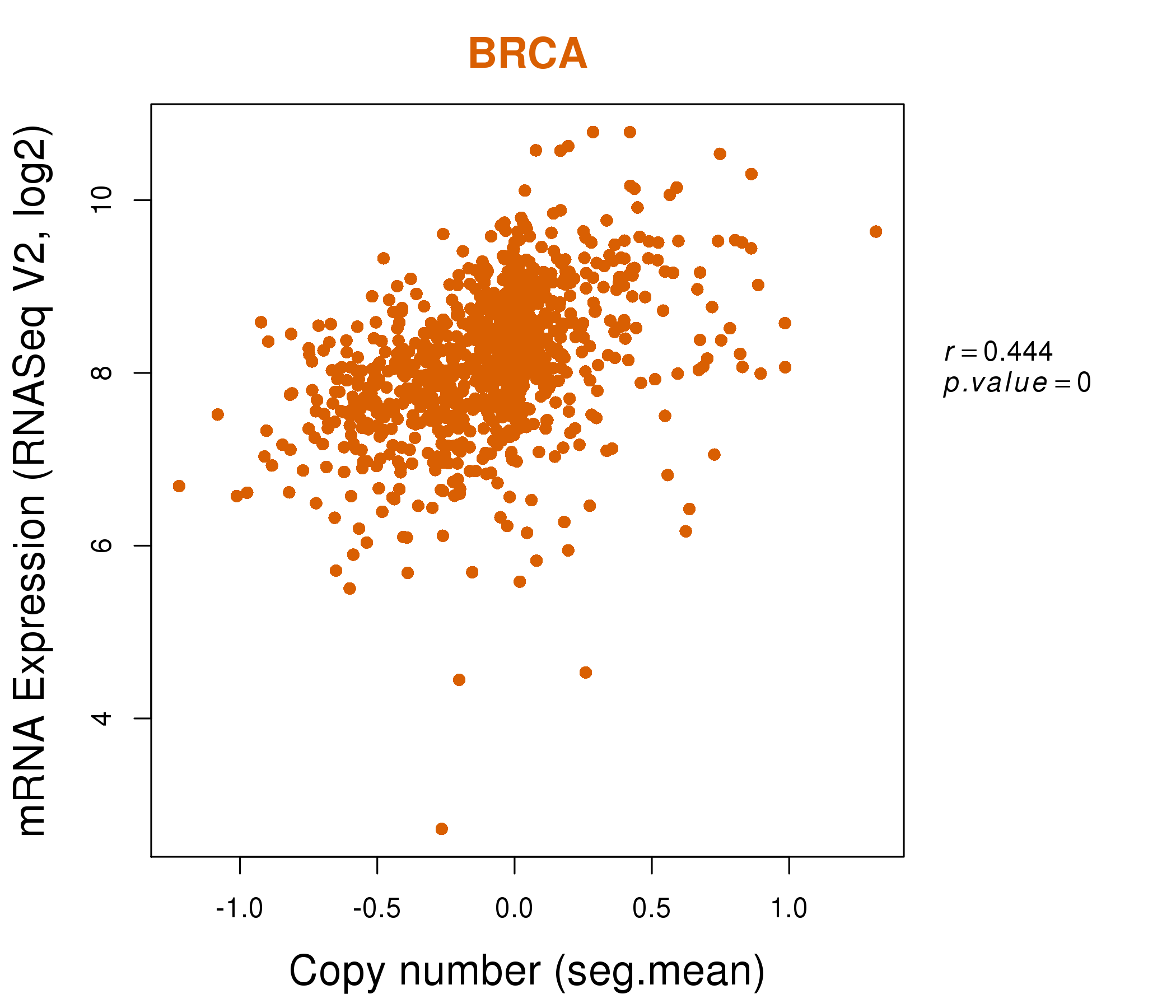|
|||||||||||||||||||||||||||||||||||||||||||||||||||||||||||||||||||||||||||||||||||||||||||||||||||||||||||||||||||||||||||||||||||||||||||||||||||||||||||||||||||||||||||||||||||||||||||||||||||||||||||||||||||||||||||||||||||||||||||||||||||||||||||||||||||||||||||||||||||||||||||||||||||||||||||||||||||||||||||||||||||||||||||||
| |
| Phenotypic Information (metabolism pathway, cancer, disease, phenome) |
| |
| |
| Gene-Gene Network Information: Co-Expression Network, Interacting Genes & KEGG |
| |
|
| Gene Summary for PCCA |
| Basic gene info. | Gene symbol | PCCA |
| Gene name | propionyl CoA carboxylase, alpha polypeptide | |
| Synonyms | - | |
| Cytomap | UCSC genome browser: 13q32 | |
| Genomic location | chr13 :100741268-101182691 | |
| Type of gene | protein-coding | |
| RefGenes | NM_000282.3, NM_001127692.2,NM_001178004.1, | |
| Ensembl id | ENSG00000175198 | |
| Description | PCCase alpha subunitpccA complementation grouppropanoyl-CoA:carbon dioxide ligase alpha subunitpropionyl Coenzyme A carboxylase, alpha polypeptidepropionyl-CoA carboxylase alpha chain, mitochondrial | |
| Modification date | 20141219 | |
| dbXrefs | MIM : 232000 | |
| HGNC : HGNC | ||
| Ensembl : ENSG00000175198 | ||
| HPRD : 01981 | ||
| Vega : OTTHUMG00000017284 | ||
| Protein | UniProt: go to UniProt's Cross Reference DB Table | |
| Expression | CleanEX: HS_PCCA | |
| BioGPS: 5095 | ||
| Gene Expression Atlas: ENSG00000175198 | ||
| The Human Protein Atlas: ENSG00000175198 | ||
| Pathway | NCI Pathway Interaction Database: PCCA | |
| KEGG: PCCA | ||
| REACTOME: PCCA | ||
| ConsensusPathDB | ||
| Pathway Commons: PCCA | ||
| Metabolism | MetaCyc: PCCA | |
| HUMANCyc: PCCA | ||
| Regulation | Ensembl's Regulation: ENSG00000175198 | |
| miRBase: chr13 :100,741,268-101,182,691 | ||
| TargetScan: NM_000282 | ||
| cisRED: ENSG00000175198 | ||
| Context | iHOP: PCCA | |
| cancer metabolism search in PubMed: PCCA | ||
| UCL Cancer Institute: PCCA | ||
| Assigned class in ccmGDB | C | |
| Top |
| Phenotypic Information for PCCA(metabolism pathway, cancer, disease, phenome) |
| Cancer | CGAP: PCCA |
| Familial Cancer Database: PCCA | |
| * This gene is included in those cancer gene databases. |
|
|
|
|
|
|
| |||||||||||||||||||||||||||||||||||||||||||||||||||||||||||||||||||||||||||||||||||||||||||||||||||||||||||||||||||||||||||||||||||||||||||||||||||||||||||||||||||||||||||||||||||||||||||||||||||||||||||||||||||||||||||||||||||||||||||||||||||||||||||||||||||||||||||||||||||||||||||||||||||||||||||||||||||||||||||||||||||||||
Oncogene 1 | Significant driver gene in | ||||||||||||||||||||||||||||||||||||||||||||||||||||||||||||||||||||||||||||||||||||||||||||||||||||||||||||||||||||||||||||||||||||||||||||||||||||||||||||||||||||||||||||||||||||||||||||||||||||||||||||||||||||||||||||||||||||||||||||||||||||||||||||||||||||||||||||||||||||||||||||||||||||||||||||||||||||||||||||||||||||||||||||
| cf) number; DB name 1 Oncogene; http://nar.oxfordjournals.org/content/35/suppl_1/D721.long, 2 Tumor Suppressor gene; https://bioinfo.uth.edu/TSGene/, 3 Cancer Gene Census; http://www.nature.com/nrc/journal/v4/n3/abs/nrc1299.html, 4 CancerGenes; http://nar.oxfordjournals.org/content/35/suppl_1/D721.long, 5 Network of Cancer Gene; http://ncg.kcl.ac.uk/index.php, 1Therapeutic Vulnerabilities in Cancer; http://cbio.mskcc.org/cancergenomics/statius/ |
| KEGG_PROPANOATE_METABOLISM REACTOME_METABOLISM_OF_LIPIDS_AND_LIPOPROTEINS | |
| OMIM | |
| Orphanet | |
| Disease | KEGG Disease: PCCA |
| MedGen: PCCA (Human Medical Genetics with Condition) | |
| ClinVar: PCCA | |
| Phenotype | MGI: PCCA (International Mouse Phenotyping Consortium) |
| PhenomicDB: PCCA | |
| Mutations for PCCA |
| * Under tables are showing count per each tissue to give us broad intuition about tissue specific mutation patterns.You can go to the detailed page for each mutation database's web site. |
| - Statistics for Tissue and Mutation type | Top |
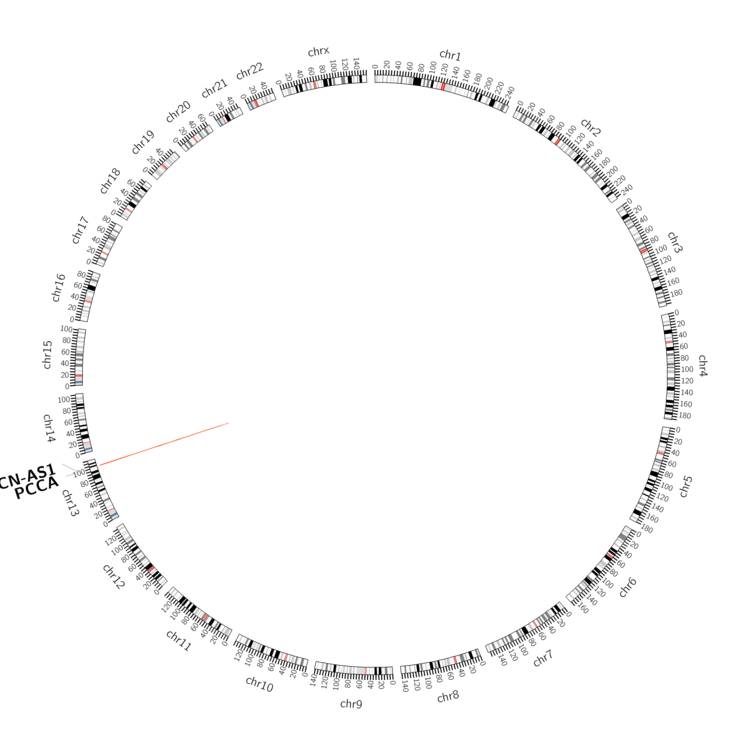 |
| - For Inter-chromosomal Variations |
| * Inter-chromosomal variantions includes 'interchromosomal amplicon to amplicon', 'interchromosomal amplicon to non-amplified dna', 'interchromosomal insertion', 'Interchromosomal unknown type'. |
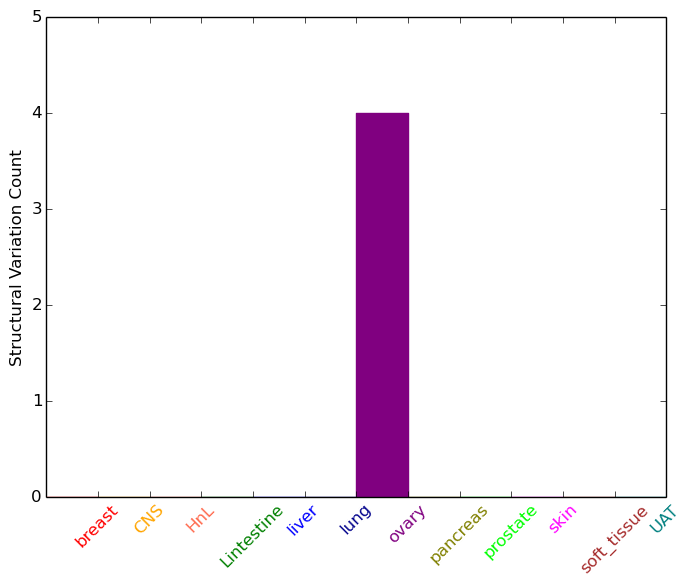 |
| - For Intra-chromosomal Variations |
| * Intra-chromosomal variantions includes 'intrachromosomal amplicon to amplicon', 'intrachromosomal amplicon to non-amplified dna', 'intrachromosomal deletion', 'intrachromosomal fold-back inversion', 'intrachromosomal inversion', 'intrachromosomal tandem duplication', 'Intrachromosomal unknown type', 'intrachromosomal with inverted orientation', 'intrachromosomal with non-inverted orientation'. |
 |
| Sample | Symbol_a | Chr_a | Start_a | End_a | Symbol_b | Chr_b | Start_b | End_b |
| central_nervous_system | PCCA | chr13 | 100767216 | 100767216 | NALCN-AS1 | chr13 | 101694698 | 101694698 |
| ovary | PCCA | chr13 | 100756606 | 100756626 | PCCA | chr13 | 100757471 | 100757491 |
| ovary | PCCA | chr13 | 100759511 | 100759531 | chr24 | 14490479 | 14490499 | |
| ovary | PCCA | chr13 | 100759511 | 100759531 | ARSD | chr23 | 2837178 | 2837198 |
| pancreas | PCCA | chr13 | 101161434 | 101161454 | PCCA | chr13 | 101153573 | 101153593 |
| cf) Tissue number; Tissue name (1;Breast, 2;Central_nervous_system, 3;Haematopoietic_and_lymphoid_tissue, 4;Large_intestine, 5;Liver, 6;Lung, 7;Ovary, 8;Pancreas, 9;Prostate, 10;Skin, 11;Soft_tissue, 12;Upper_aerodigestive_tract) |
| * From mRNA Sanger sequences, Chitars2.0 arranged chimeric transcripts. This table shows PCCA related fusion information. |
| ID | Head Gene | Tail Gene | Accession | Gene_a | qStart_a | qEnd_a | Chromosome_a | tStart_a | tEnd_a | Gene_a | qStart_a | qEnd_a | Chromosome_a | tStart_a | tEnd_a |
| AI951320 | PCNP | 28 | 83 | 3 | 101313224 | 101313279 | PCCA | 78 | 525 | 13 | 100809560 | 100921006 | |
| BE071691 | PCCA | 14 | 445 | 13 | 100818025 | 100818454 | PCCA | 434 | 612 | 13 | 100820153 | 100820334 | |
| BF811509 | MALAT1 | 11 | 368 | 11 | 65271972 | 65272331 | PCCA | 363 | 430 | 13 | 101171483 | 101171550 | |
| BE071684 | PCCA | 6 | 438 | 13 | 100818025 | 100818455 | PCCA | 427 | 601 | 13 | 100820153 | 100820328 | |
| BG980943 | PCCA | 1 | 131 | 13 | 101119337 | 101119477 | SERPINE1 | 118 | 388 | 7 | 100778865 | 100780774 | |
| Top |
| Mutation type/ Tissue ID | brca | cns | cerv | endome | haematopo | kidn | Lintest | liver | lung | ns | ovary | pancre | prost | skin | stoma | thyro | urina | |||
| Total # sample | 4 | 1 | 1 | 2 | 2 | 1 | 1 | |||||||||||||
| GAIN (# sample) | 4 | 1 | 1 | 1 | 1 | 1 | ||||||||||||||
| LOSS (# sample) | 1 | 1 | 1 |
| cf) Tissue ID; Tissue type (1; Breast, 2; Central_nervous_system, 3; Cervix, 4; Endometrium, 5; Haematopoietic_and_lymphoid_tissue, 6; Kidney, 7; Large_intestine, 8; Liver, 9; Lung, 10; NS, 11; Ovary, 12; Pancreas, 13; Prostate, 14; Skin, 15; Stomach, 16; Thyroid, 17; Urinary_tract) |
| Top |
|
 |
| Top |
| Stat. for Non-Synonymous SNVs (# total SNVs=54) | (# total SNVs=9) |
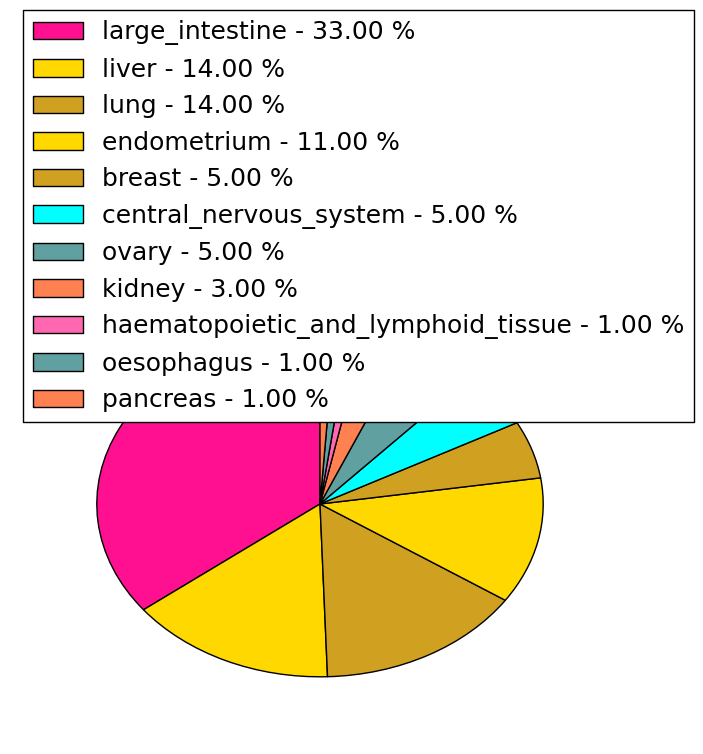 | 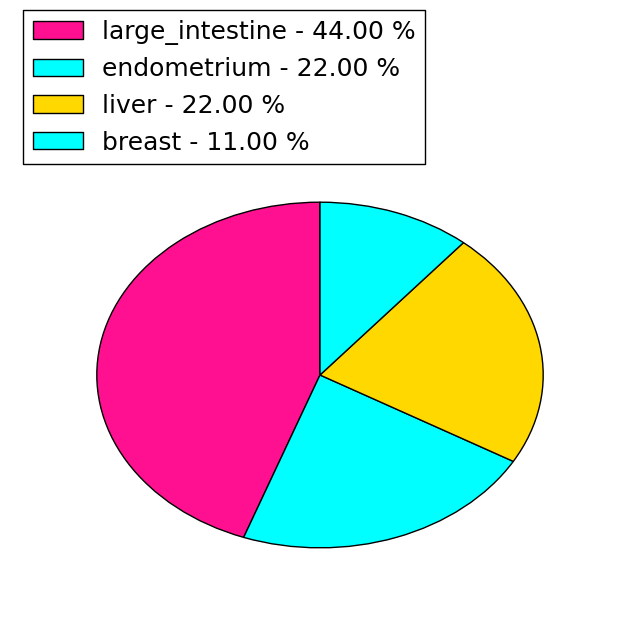 |
(# total SNVs=2) | (# total SNVs=1) |
 | 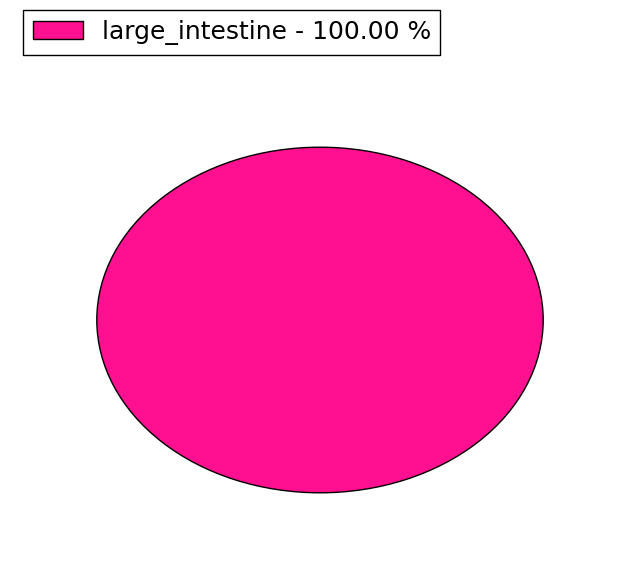 |
| Top |
| * When you move the cursor on each content, you can see more deailed mutation information on the Tooltip. Those are primary_site,primary_histology,mutation(aa),pubmedID. |
| GRCh37 position | Mutation(aa) | Unique sampleID count |
| chr13:100909900-100909900 | p.R230H | 6 |
| chr13:101077939-101077939 | p.S600L | 3 |
| chr13:100809577-100809577 | p.E151* | 3 |
| chr13:101077972-101077972 | p.Q611L | 3 |
| chr13:101020767-101020767 | p.S562L | 3 |
| chr13:101020796-101020796 | p.V572I | 3 |
| chr13:100953816-100953816 | p.R390C | 2 |
| chr13:100809554-100809554 | p.Y143C | 2 |
| chr13:101077983-101077983 | p.Q615K | 2 |
| chr13:100861692-100861692 | p.I192N | 2 |
| Top |
|
 |
| Point Mutation/ Tissue ID | 1 | 2 | 3 | 4 | 5 | 6 | 7 | 8 | 9 | 10 | 11 | 12 | 13 | 14 | 15 | 16 | 17 | 18 | 19 | 20 |
| # sample | 2 | 15 | 2 | 4 | 2 | 7 | 2 | 1 | 8 | 8 | 1 | 6 | ||||||||
| # mutation | 2 | 16 | 2 | 4 | 2 | 8 | 2 | 1 | 8 | 5 | 1 | 7 | ||||||||
| nonsynonymous SNV | 1 | 13 | 2 | 4 | 2 | 7 | 2 | 1 | 4 | 5 | 5 | |||||||||
| synonymous SNV | 1 | 3 | 1 | 4 | 1 | 2 |
| cf) Tissue ID; Tissue type (1; BLCA[Bladder Urothelial Carcinoma], 2; BRCA[Breast invasive carcinoma], 3; CESC[Cervical squamous cell carcinoma and endocervical adenocarcinoma], 4; COAD[Colon adenocarcinoma], 5; GBM[Glioblastoma multiforme], 6; Glioma Low Grade, 7; HNSC[Head and Neck squamous cell carcinoma], 8; KICH[Kidney Chromophobe], 9; KIRC[Kidney renal clear cell carcinoma], 10; KIRP[Kidney renal papillary cell carcinoma], 11; LAML[Acute Myeloid Leukemia], 12; LUAD[Lung adenocarcinoma], 13; LUSC[Lung squamous cell carcinoma], 14; OV[Ovarian serous cystadenocarcinoma ], 15; PAAD[Pancreatic adenocarcinoma], 16; PRAD[Prostate adenocarcinoma], 17; SKCM[Skin Cutaneous Melanoma], 18:STAD[Stomach adenocarcinoma], 19:THCA[Thyroid carcinoma], 20:UCEC[Uterine Corpus Endometrial Carcinoma]) |
| Top |
| * We represented just top 10 SNVs. When you move the cursor on each content, you can see more deailed mutation information on the Tooltip. Those are primary_site, primary_histology, mutation(aa), pubmedID. |
| Genomic Position | Mutation(aa) | Unique sampleID count |
| chr13:100909900 | p.R204H,PCCA | 5 |
| chr13:100915005 | p.Q221E,PCCA | 2 |
| chr13:101077904 | p.F311F,PCCA | 1 |
| chr13:100953732 | p.H454Y,PCCA | 1 |
| chr13:100962160 | p.I661M,PCCA | 1 |
| chr13:100807338 | p.G116C,PCCA | 1 |
| chr13:100915016 | p.F321L,PCCA | 1 |
| chr13:101077918 | p.I464I,PCCA | 1 |
| chr13:100953772 | p.T680T,PCCA | 1 |
| chr13:100982823 | p.Y117C,PCCA | 1 |
| * Copy number data were extracted from TCGA using R package TCGA-Assembler. The URLs of all public data files on TCGA DCC data server were gathered on Jan-05-2015. Function ProcessCNAData in TCGA-Assembler package was used to obtain gene-level copy number value which is calculated as the average copy number of the genomic region of a gene. |
 |
| cf) Tissue ID[Tissue type]: BLCA[Bladder Urothelial Carcinoma], BRCA[Breast invasive carcinoma], CESC[Cervical squamous cell carcinoma and endocervical adenocarcinoma], COAD[Colon adenocarcinoma], GBM[Glioblastoma multiforme], Glioma Low Grade, HNSC[Head and Neck squamous cell carcinoma], KICH[Kidney Chromophobe], KIRC[Kidney renal clear cell carcinoma], KIRP[Kidney renal papillary cell carcinoma], LAML[Acute Myeloid Leukemia], LUAD[Lung adenocarcinoma], LUSC[Lung squamous cell carcinoma], OV[Ovarian serous cystadenocarcinoma ], PAAD[Pancreatic adenocarcinoma], PRAD[Prostate adenocarcinoma], SKCM[Skin Cutaneous Melanoma], STAD[Stomach adenocarcinoma], THCA[Thyroid carcinoma], UCEC[Uterine Corpus Endometrial Carcinoma] |
| Top |
| Gene Expression for PCCA |
| * CCLE gene expression data were extracted from CCLE_Expression_Entrez_2012-10-18.res: Gene-centric RMA-normalized mRNA expression data. |
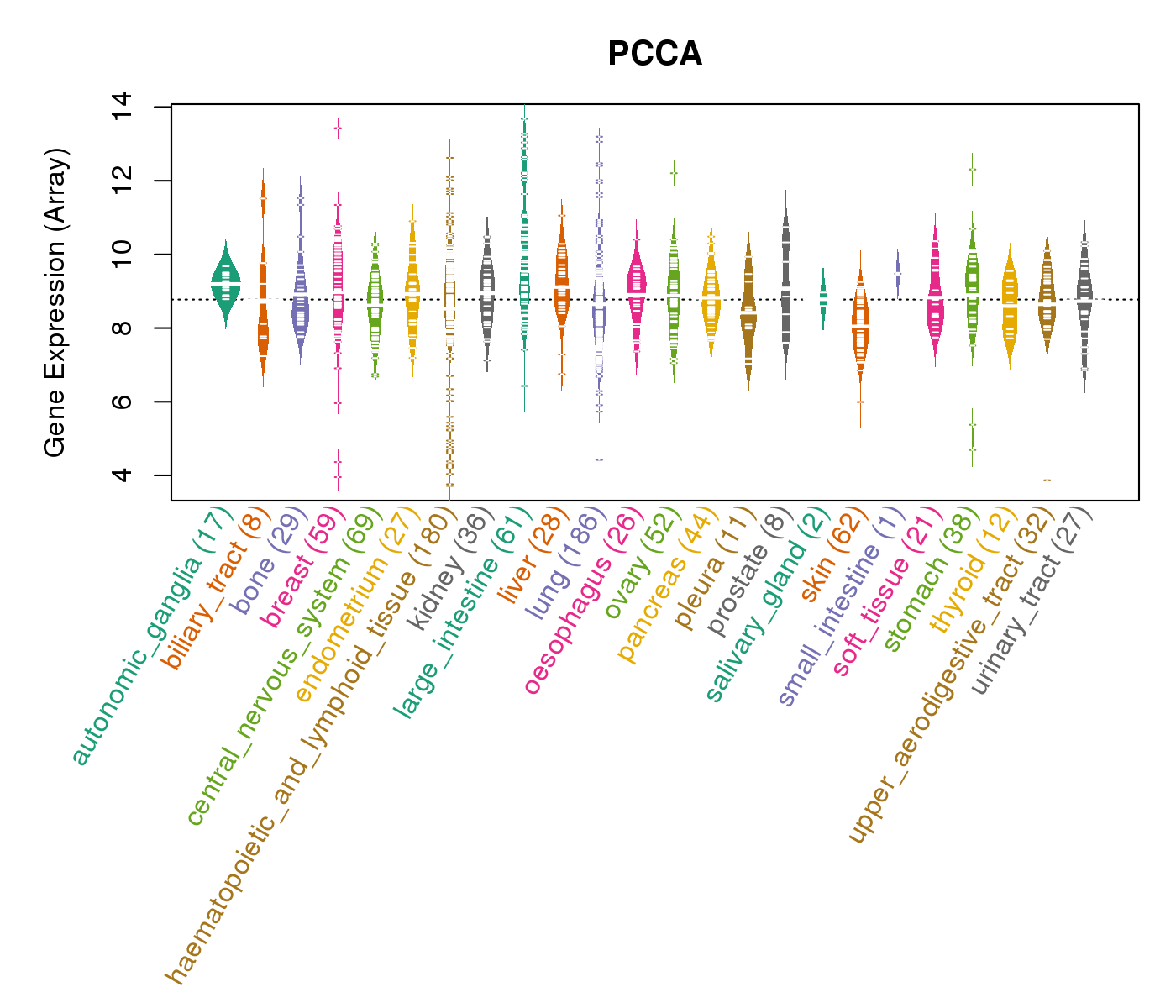 |
| * Normalized gene expression data of RNASeqV2 was extracted from TCGA using R package TCGA-Assembler. The URLs of all public data files on TCGA DCC data server were gathered at Jan-05-2015. Only eight cancer types have enough normal control samples for differential expression analysis. (t test, adjusted p<0.05 (using Benjamini-Hochberg FDR)) |
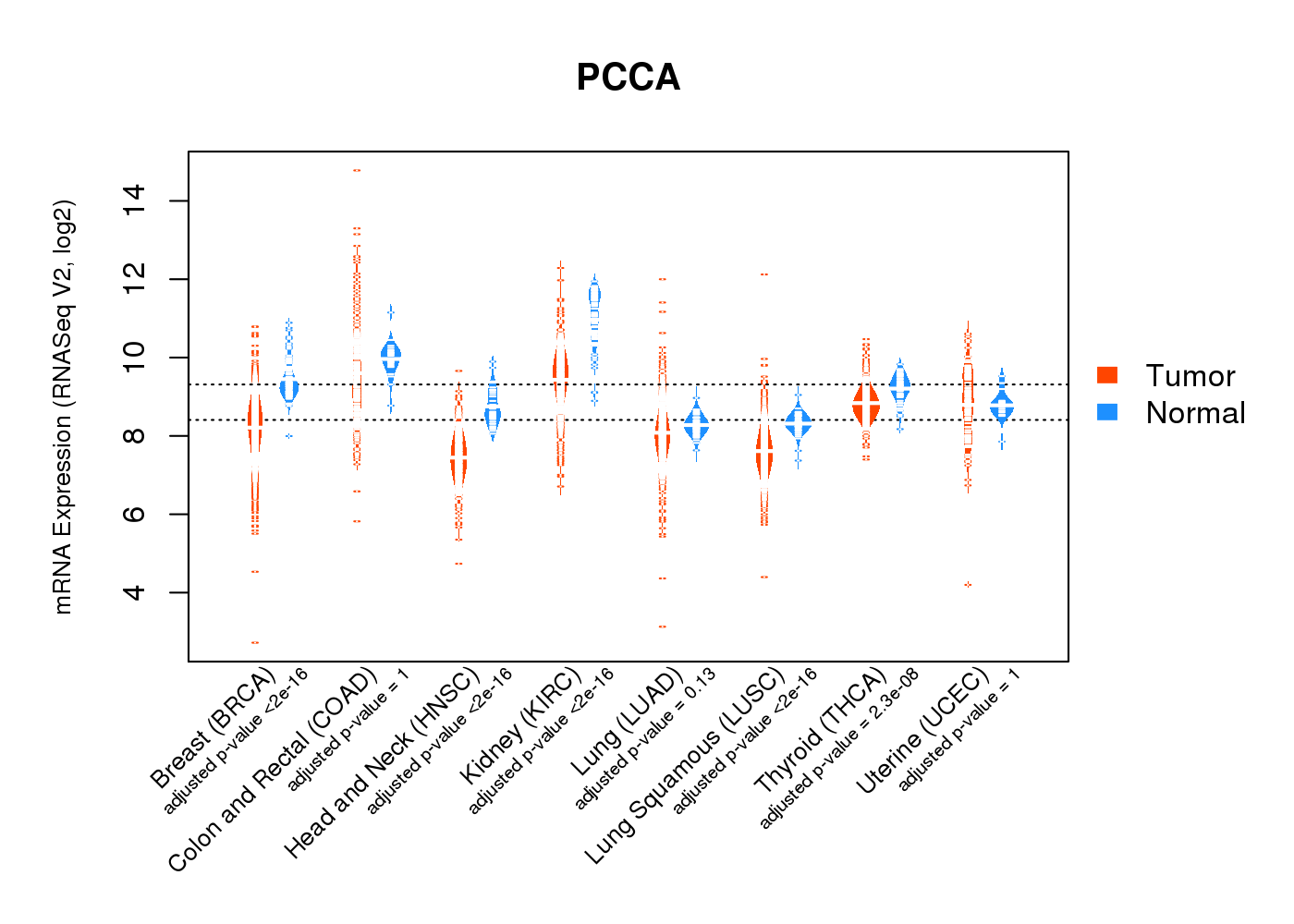 |
| Top |
| * This plots show the correlation between CNV and gene expression. |
: Open all plots for all cancer types
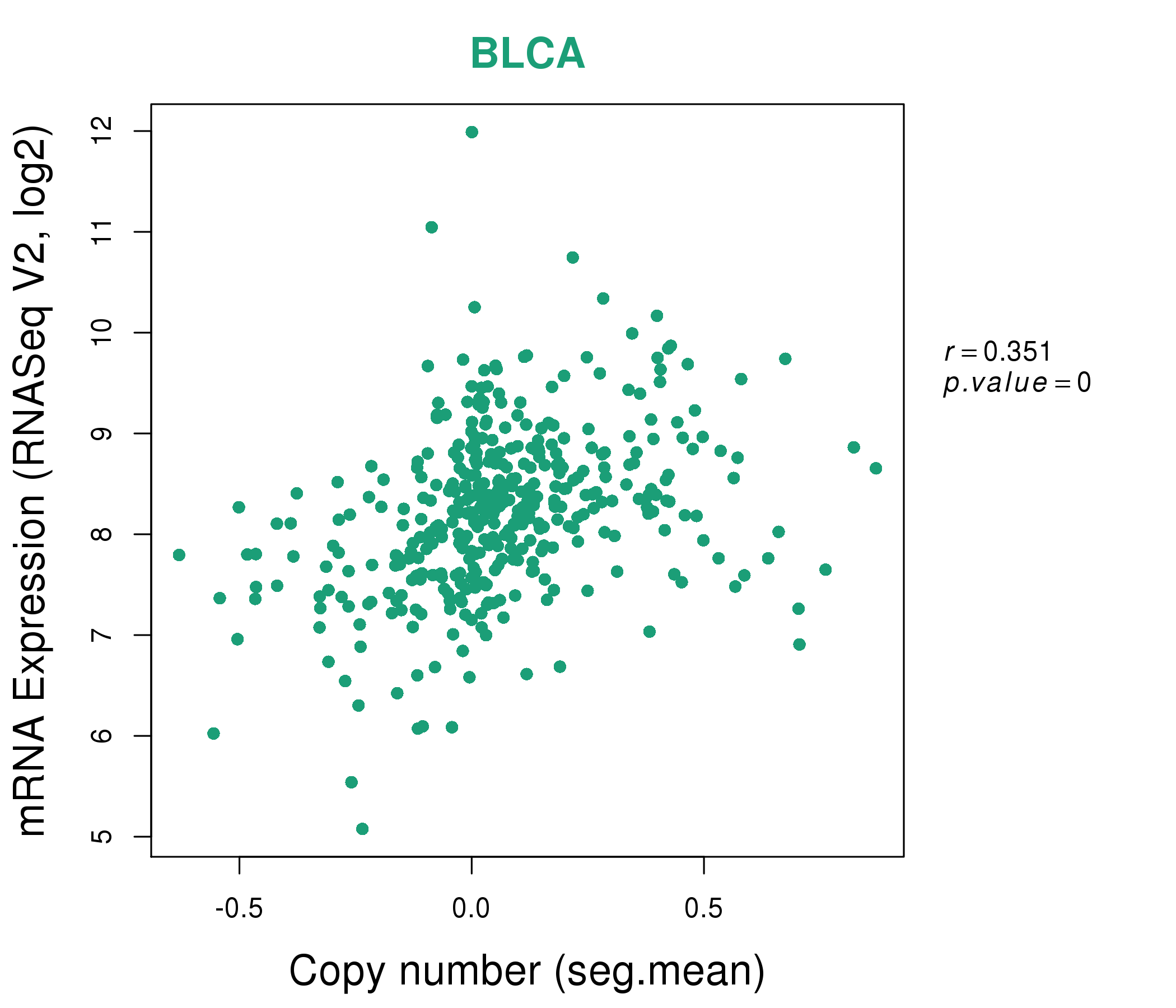 |
|
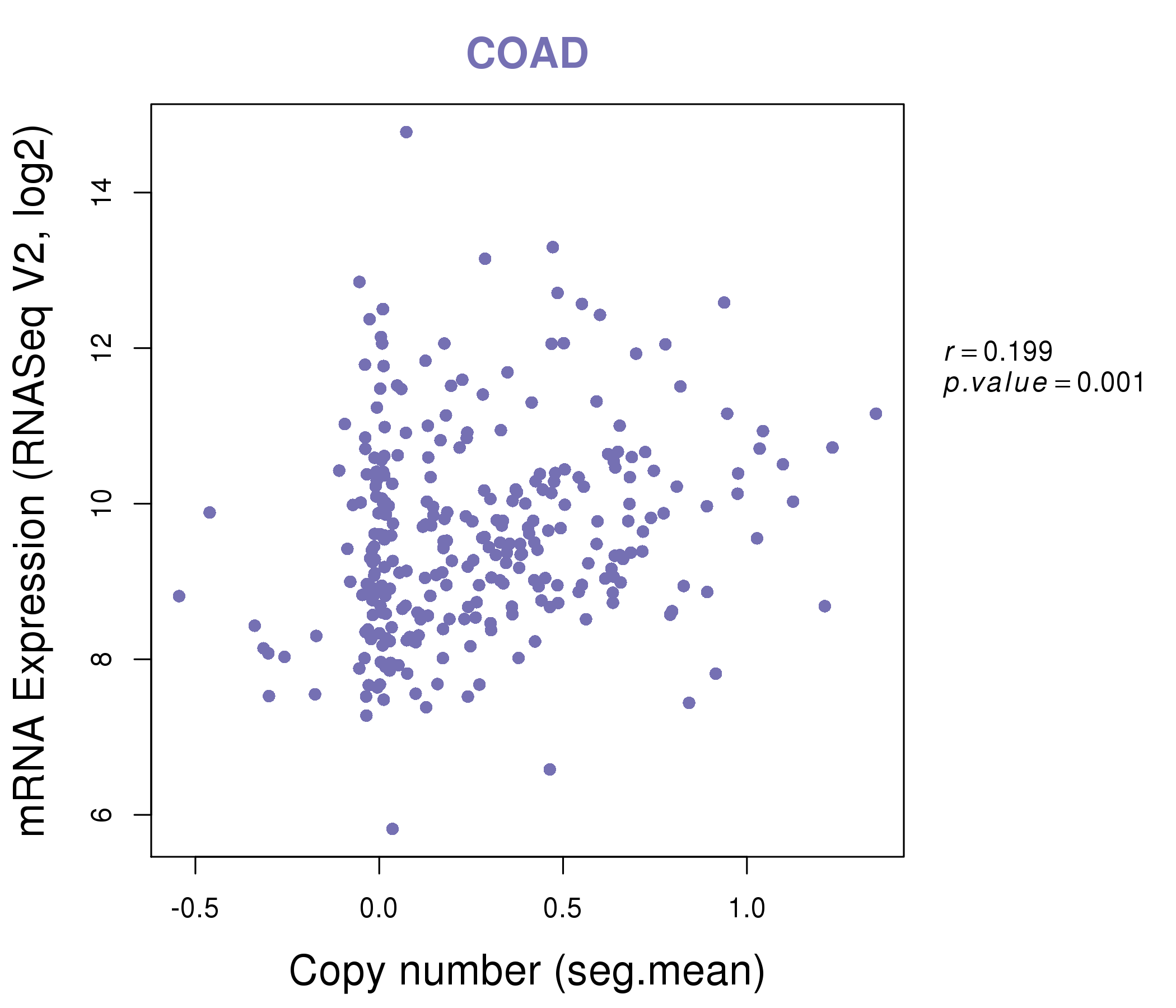 |
|
| Top |
| Gene-Gene Network Information |
| * Co-Expression network figures were drawn using R package igraph. Only the top 20 genes with the highest correlations were shown. Red circle: input gene, orange circle: cell metabolism gene, sky circle: other gene |
: Open all plots for all cancer types
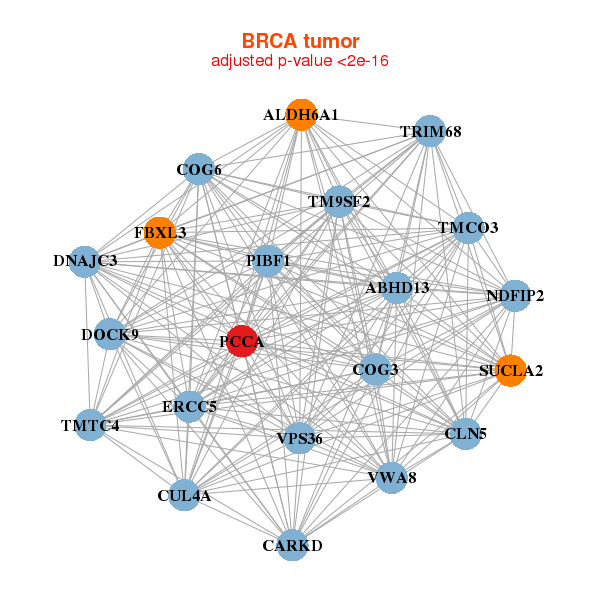 |
| ||||
| ABHD13,ALDH6A1,CARKD,CLN5,COG3,COG6,CUL4A, DNAJC3,DOCK9,ERCC5,FBXL3,VWA8,NDFIP2,PCCA, PIBF1,SUCLA2,TM9SF2,TMCO3,TMTC4,TRIM68,VPS36 | ABHD15,ACACB,ACSS3,ACVR1C,ADH1B,ALDH6A1,BNIP3L, RHOV___CHP1,CYB5A,GHR,GYG2,HADH,IDH1,LGALS12, LOC283392,MARC1,MARC2,OXCT1,PCCA,PECR,PEX19 | ||||
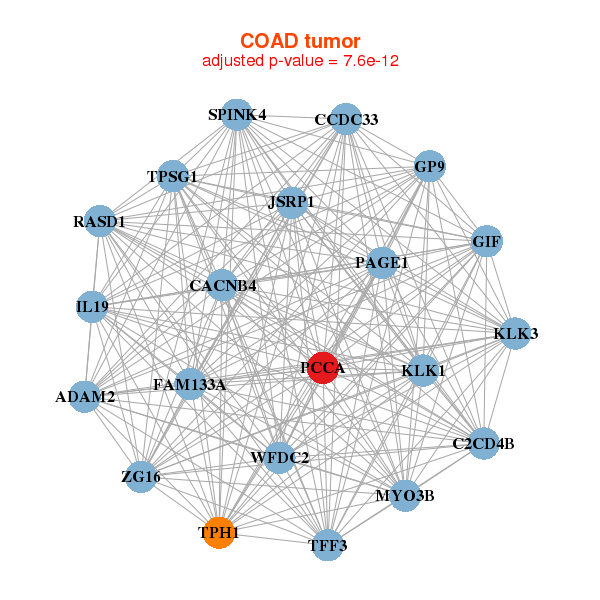 |
| ||||
| ADAM2,C2CD4B,CACNB4,CCDC33,FAM133A,GIF,GP9, IL19,JSRP1,KLK1,KLK3,MYO3B,PAGE1,PCCA, RASD1,SPINK4,TFF3,TPH1,TPSG1,WFDC2,ZG16 | ADH1C,ATP5A1,B4GALNT2,BCKDHB,APMAP,FAM45A,FAM45B, GJB1,HADH,IGFBP2,LRPPRC,MEST,METAP1,NDUFA10, PCCA,PCCB,PITX2,SDR42E1,SUCLG2,SUPV3L1,TBRG4 |
| * Co-Expression network figures were drawn using R package igraph. Only the top 20 genes with the highest correlations were shown. Red circle: input gene, orange circle: cell metabolism gene, sky circle: other gene |
: Open all plots for all cancer types
| Top |
: Open all interacting genes' information including KEGG pathway for all interacting genes from DAVID
| Top |
| Pharmacological Information for PCCA |
| DB Category | DB Name | DB's ID and Url link |
| * Gene Centered Interaction Network. |
 |
| * Drug Centered Interaction Network. |
| DrugBank ID | Target Name | Drug Groups | Generic Name | Drug Centered Network | Drug Structure |
| DB00121 | propionyl CoA carboxylase, alpha polypeptide | approved; nutraceutical | Biotin |  |  |
| Top |
| Cross referenced IDs for PCCA |
| * We obtained these cross-references from Uniprot database. It covers 150 different DBs, 18 categories. http://www.uniprot.org/help/cross_references_section |
: Open all cross reference information
|
Copyright © 2016-Present - The Univsersity of Texas Health Science Center at Houston @ |






